Boat Review
THE MARCO 750 EVOLUTION WHEN A PLAN COMES TOGETHER
Luke Davis is one of New Zealand’s best known game fishermen, and is also well known for his shallow-water snapper and kingfish exploits. So, when his new boat Evo was launched late last year, it attracted a huge amount of attention – not least because he had a huge influence in the design. Northland contributor Pete McGregor checks out what the fuss is about.

Luke had been happy with his previous boat – a650 Marco. This time he wanted a full walk-around vessel, with space to accommodate 4-5 anglers; comfortable sleeping room for three; a good turn of speed even in boisterous conditions; all round fishability for snapper and kingfish angling; and, importantly, the ability to back down on a marlin. Naturally, he turned to Dayne Horne at Marco boats, recognising him as the type of engineer who is more than happy to collaborate with clients to achieve their specific aspirations. Evo is based on a standard Marco 750 hull, (read: strong) with eight 5mm stringers, 6mm hull and 4mm sides, plus a good ride. Luke’s boat will feature on the Lateral Line fishing series for offshore fishing adventures.

1) The uncluttered forward casting platform is Luke’s favourite place to lure-fish from.
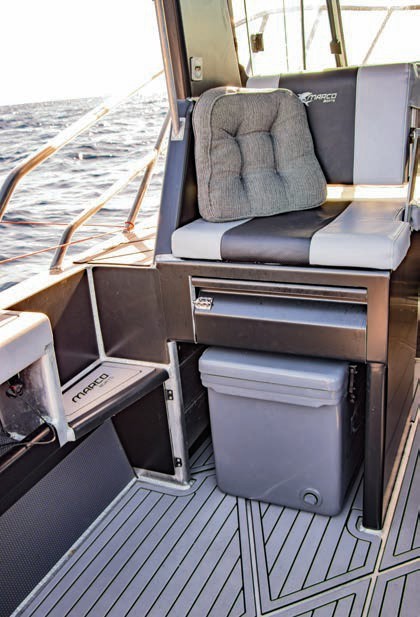
3) The port rear-facing seat with tackle drawer and chilly bin space underneath.
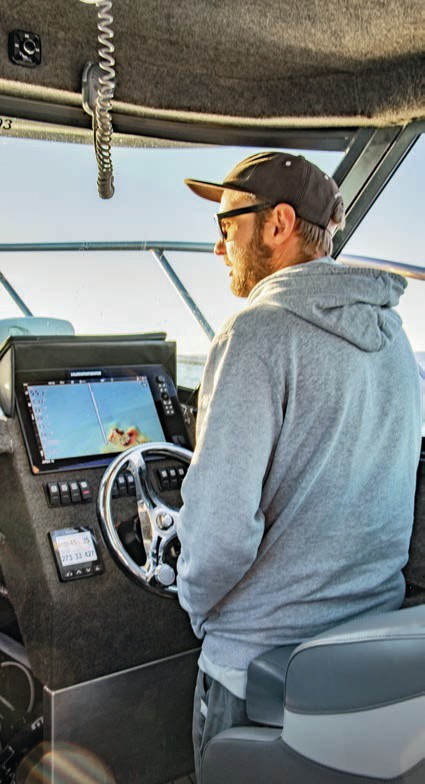
2) A big 16-inch Hummingbird dominates the dash.
I should point out that this is a keen, hardworking angler’s boat. There will be no glamour photos of immaculately pristine decks and cabins. In the six months since launch, the motor has already clocked 270 hours. It’s stuffed full of top-quality high-performance fishing gear. For this boat review, we decided to go the extra mile. As Luke says, “What better way to demonstrate the capabilities of a marlin machine than to go fishing for marlin?”
The start of the trip entailed getting to Luke’s house by 4:30am so that we could travel to the launch spot in Tairua. My first impression of the boat was how big it is. Even in the darkness, at 8.2 metres overall, Evo dominates Luke’s Toyota ute with its sheer mass. Despite this, the Toyota made light work of towing the big rig on its custom Marco trailer. Luke explained that he wanted to keep the total rig weight under 3500kg. All up – fully laden with gear and a full 450 litre fuel load – they’ve achieved a weight of 3450kg.
We reached Tairua in semi-darkness and were joined by Dayne Horne from Marco, and BLA’s Sascha Haag. This was Dayne’s first real test of the boat, and Sascha was along to help Luke with some fine tuning of the Hummingbird systems. After rigging the game poles, Evo slipped into the water and the big Suzuki 300V6 idled us out of the river. It’s a well-balanced boat, with a dramatic shearline rising midcabin that allows for a wide walk-around but also leaves good head height inside the forward cabin. The bow has tall rails to keep anglers fishing from this position secure and on board.
A unique transom
The most obvious of the vessel’s unique features is the transom. Unlike most trailer boats that have a complex transom step and outboard pod arrangement, Evo has a cut-off stern not unlike a big launch. The only modification is a small cut-out at the bottom of the transom on each side to allow for the installation of trim tabs etc.
Even the huge Airmar transducer is partially set into the hull. The Suzuki is flush-mounted on the transom with a large outboard well intruding into the cockpit. On each side of the stern are large live bait tanks, and a trio of tuna tubes fit neatly into the leading edge of the well, which also incorporates three rod holders. These tubes are covered with a clip-on bait board when required. There is no transom door. Luke’s focus is on tagging and releasing game fish, and so with this in mind, Evo does not even carry a gaff.
The large cockpit is clean, with thigh-high 800mm gunwales neatly wrapped with U-Deck, and five rod holders lining each side. Where the cockpit meets the cabin, there are substantial steps to aid with access to the walkaround side decks. One modification Luke would do next time is to incorporate two steps up rather than the one. However, the bonus is that these steps also serve as temporary seating. Beside the steps, small doors open to reveal two rod storage tubes on each side. These can hold up to four 8’3” rods (with spinning reels attached), making them instantly available – very neat. The ‘rocket launcher’ provides a further seven rod holders.
Excellent headroom
The main cabin is spacious, even with the walk-around set up. Dayne is 6’3” and there was at least 6” clearance above his head.

1) Evo boasts plenty of fishing room – note the twin livebait tank setups.

3) Rods are stored in specially made racks on the forward cabin top. A mini bunk provides additional rod storage on the right.
Large roof hand-holds run the length of the cabin’s central walkway, beside which Luke has fitted rod holders for a further six stickbait rods. Seating is on raised plinths on each side of this walkway. On the starboard side, there is a comfortable adjustable skipper’s chair with a rear-facing seat behind. This incorporates a drop-down leg rest (which remained up for the test as it made a comfortable position for watching lures).
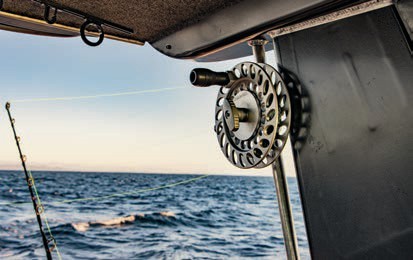
2) Reels inside the cabin give the crew control over the teasers.

4) The MinnKota is deployed over the bow, with the anchor recessed.
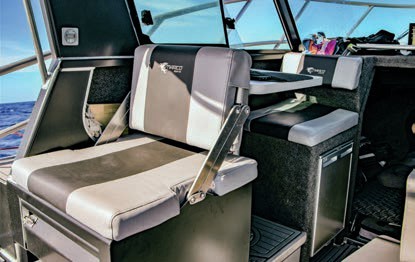
5) The port side seating is reversible.
Under this seat is a rubbish bin, tackle storage, and space for a barbeque. The port side features a rear-facing seat, a table, and a rear seat which can be swung to face forward or towards the stern. The table drops down to form a bed – or what Luke calls the sleeper seat – another extremely comfortable spot to observe lures. It is so comfortable that crew usually last only 45 seconds before falling asleep, according to Luke (hence the name).
Under this combination is a small fridge, and there is space for a fish bin to fit snugly under the rear-most seat, which also holds another tackle drawer. Batteries for the MinnKota fit under the floor (under the table base), and main batteries are under the floor on the starboard side. Lumitec lights illuminate the cockpit area.
There are large windows on both sides of the cabin that can slide from either the front or rear.
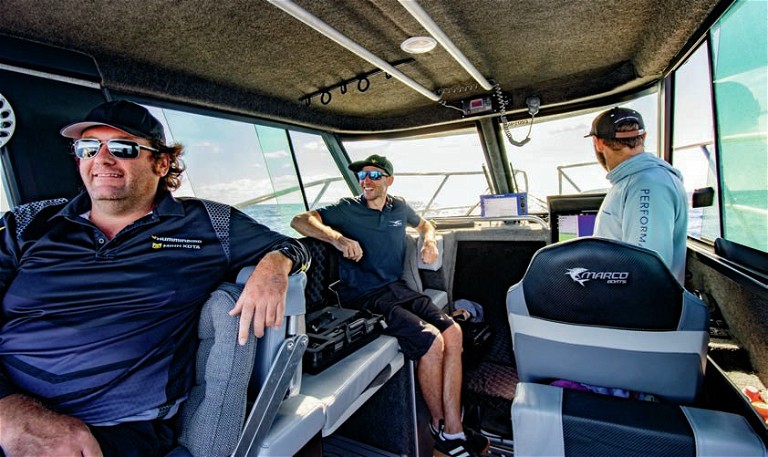
6) The cabin seating arrangements are made with comfort in mind.
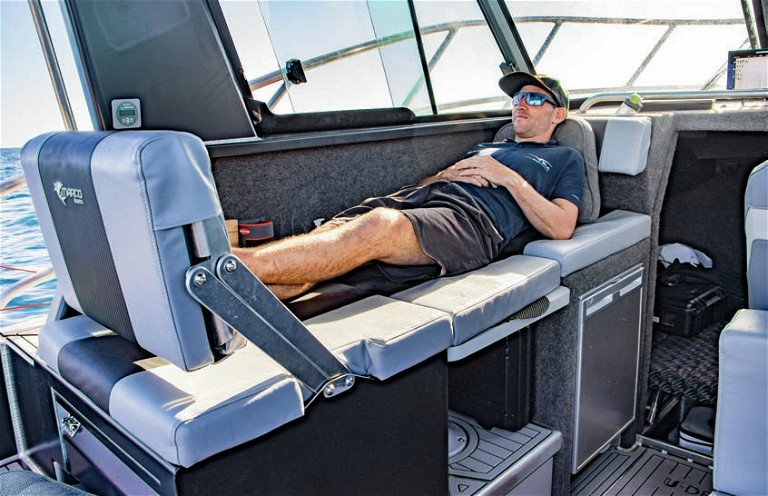
7) The sleep seat – the most popular place from which to watch the lures!
Extensive electronics package
The dash is dominated by a builtin Hummingbird Apex 16 MSI+. This runs 1kw down imaging and side imaging on hi, and 2kw on low, directly from that big Airmar R109 L/HW 2kw transducer. A Humminbird Solix 10 MSI+ is mounted on top of the dash as a secondary unit. This combination gives many options for running multiple screens with imaging, charts, sonar, and radar. To the right of the skipper’s chair are controls for the Suzuki, including a push-button start. Behind the gear lever are switches controlling the various tuna tube and bait tank pumps, plus trim tab controls.
Behind this, in the side pocket, are the conveniently placed main battery switches. Luke and Dayne laughed as they described the challenging decision they had to make about which steering wheel to choose. Luke had his heart set on a cheaper one, but Dayne vetoed it in favour of a fancier, more expensive one. The two show a great rapport with one another, with one providing the vision, while the other works out the practicalities of making it into a reality.
Forward of the main cabin and hidden behind a sliding door is the sleeping cabin, with an in-fill bunk squab that is a cosy sleeping spot for two. The skipper’s footrest panel drops down to extend the bunk on that side for “bigger buggers”. There is a pole and canvas upper pull-out mini-bunk arrangement on the starboard side that provides storage for personal gear, and extra rods if needed. The four game rods fit in to racks on the roof of this cabin – avery neat, tidy, and secure arrangement. A small, clear hatch gives direct access to the foredeck and provides ventilation. A toilet fitted under the mid-bunk proved convenient during the trip.
Unique outrigger bases
As you walk around the sides of the boat, a major feature of Evo becomes evident. The “Stealthtech” outrigger pole bases – conceived by Luke and designed by Dayne – are very neatly concealed in recesses on the rear cabin pillar. A simple clip holds them in an upright position for cruising. This is a great feature – preventing damage to the legs of any angler as they fight a stroppy fish forward or rearward – on the side decks where conventional outrigger bases can be an issue.
The forward deck is a masterpiece of angler-friendly design, with lots of space, flat deck areas, and the safety of those big, tall rails. Luke loves this area and most of his fishing for snapper and kingfish is done from here or from the cabin top. Luke says that if he had to start again, he would make the foredeck bigger and the cockpit smaller by moving the cabin rearwards. Dayne shook his head quietly at this – ”Nah, it would look silly mate.”
Obviously, a large part of the success of fishing this boat is down to the big Minn Kota (87inch, 112lb thrust, I PILOT LINK Terrova). It comes with advanced options like recording tracks and circle mode, and can be operated from the chart. Deploying over the top of the anchor, the MinnKota did not require modification of the bow rails. The anchor itself deploys out from under the Minn Kota and uses a drum winch hidden under a forward hatch. The cabin roof is fully U-Decked and incorporates a large LED spotlight and fitting for a multifunctional screen to be used when operating the Minn Kota from the foredeck.
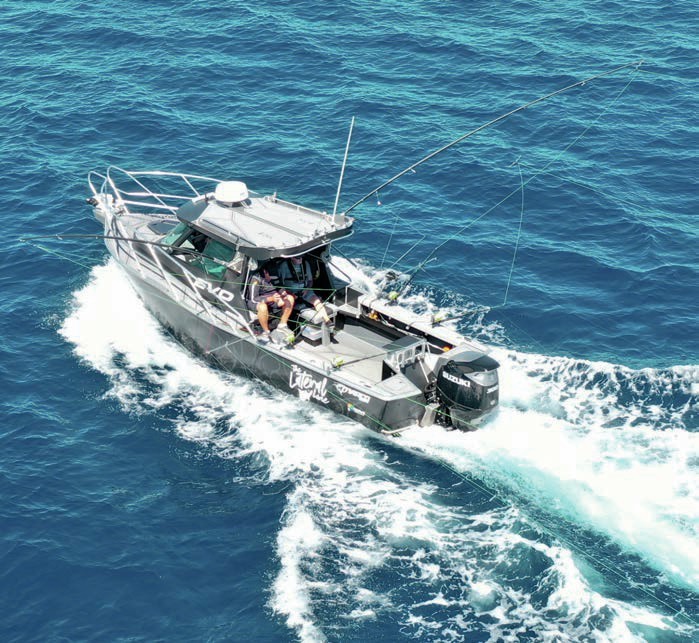

Throughout the boat are fitted flush-mounted pop-up cleats to prevent snagging gear or tripping when fighting fish. The standard of finish is very high, with all internal surfaces wrapped in black vinyl (except for the impressive welds which are a work of art in themselves!). Brave Design did the elegant wrap. Black deck tread covers the internal sides of the cockpit down to the cockpit floor, and U-Deck has been used for all foot traffic areas, the cockpit floor, the foredeck, and even the cabin roof.
The motor is a 300 HP Suzuki V6, the main feature of which is the counter-rotating props, which enable it to reverse at speed in both directions (unlike single prop motors that are good in one direction but awful on the opposite lock). The motor is very tall and dominates the stern area, obstructing the view of lures somewhat from the lower starboard seat.
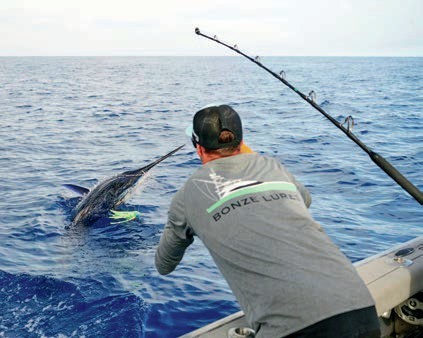
At the time of writing, Evo had 10 marlin to her credit, attributed in part to the strong pulling-power of the Suzuki outboard.
Overall impressions
How does all this work? Well, pretty damn good actually. Immediately upon leaving the harbour, Luke increased the speed to about 22 knots, which is the most economical cruising speed. At this speed, the motor is a bit noisy but not enough to interfere with conversation.
At trolling speeds, the motor settles into a muted rumble – not unlike what you would expect from a launch inboard diesel actually – and this created a suitably attractive sound to pull marlin (it obviously works, as Evo has claimed 10 marlin at time of writing). Evo is very stable, both at speed and trolling, and those seats are comfortable! Visibility is good from the helm. Luke and Dayne are looking at motor height adjustments to improve economy and maybe bring the bow down a wee bit.
Luke ran a set of four Bonze light gauge lures, along with dredges on both sides of the boat using poles to which he has fitted Diawa Tanacom electric reels. The dredge line runs from a mid-pole ring out to a pulley on the dredge and back, via the end of the pole to the Diawa – effectively doubling the Tanacom’s drag to manage the weight. It works well, and on hookup you just flick the retrieve lever on the reel to haul the dredge in. His teasers run from small handreels mounted inside the cabin pillar via pulleys on the outriggers.
We trolled all day out around the trench and eventually had a strike on the long corner. Unfortunately, the marlin dropped off after a short run, much to Sascha’s disappointment (he was on rod duty). Dayne turned to me and asked if we were likely to get another strike. My response was:“Hey this is Luke Davis we’re with.
If anyone can pull another one, he will!” (We had four strikes last time I was out with Luke on my own boat.) However, it was not to be this time. As Luke likes to call it, it was a “reality check”.
By this time the wind had come up and we anticipated a lumpy ride home. Luke invited Dayne to take the wheel and do whatever he wanted (he had never driven her before), so it was a boisterous ride in with Dayne not sparing the horses and disdaining the choppy swells – this boat can really honk.
Top speed is in the upper 30 knot range, though we did not see that in these conditions. Luke likes the fact that he can get home at speed in 20-knot winds from the Barrier if required, and certainly Evo just shouldered aside the waves in impressive fashion. At upper 20-knot speeds, the big Suzuki makes itself heard.
Backing up hard
Once in the shelter of the islands, Luke took over to demonstrate the boat’s main feature: its ability to reverse hard. We did seven knots turning hard to both port and starboard. The mighty Evo was able to turn in a miniscule 3-4 metre turning circle, in reverse, without any wash coming over the stern. A good-sized wake could be seen off the bow – very impressive, and ideal for chasing down and leadering a marlin.
Dayne then took the wheel as we motored into the harbour and drove Evo up onto the trailer. Overall, a very impressive craft. Marco boats can utilise most of the Evo features in a boat made for any client.
I asked what Luke liked best about Evo; he replied: “The fantastic reversing, the foredeck fishing, and the Minn Kota.” He says he will never again have a boat without those features. What do you hate about Evo, Luke?“Nothing really. I designed it after all, and I’m pretty damn happy. Maybe improve the wipers?”